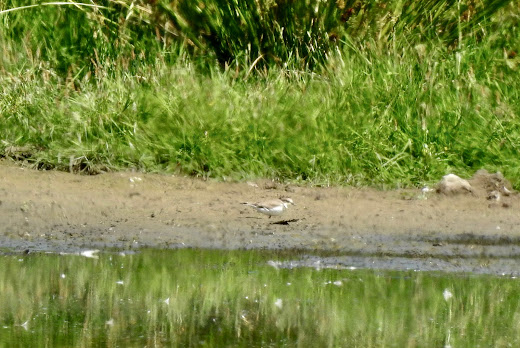A warm, soon to be hot, summer morning at Morton Bagot is not the kind of day you expect anything of any significance to happen. In fact I remarked to Dave shortly after he arrived that I had already had the bird of the day, a Yellowhammer heard singing as I turned into the northern edge of the recording area. How wrong I was!
Sometimes good days turn on tiny decisions. After we had walked down the access road to look over the pond at Clowse Farm, I floated the idea of heading for Bannams Wood in the hope of finding some good butterflies. Fortunately the idea passed without serious consideration and we opted for the normal route.
Thus it was that twenty minutes later we were walking along the track towards the beehives when I casually lifted my bins to look at a Buzzard flying towards us. There was something odd about its flight, the slightly droopy floppy lazy wing-dangly way it approached. I stayed on it for a split second longer than I had intended, and with rising excitement said "what's this?' As it approached it gained height and we were both concentrating on seeing the tail, which proved to have the right bands across it. HONEY BUZZARD. Mayhem ensued.
By good fortune my camera was around my neck (but it was set for close focus for insects.) Dave stayed on the bird as it rose higher and started circling. I eventually got the camera into some sort of auto mode and fired off about seven shots, mostly of sky and bits of foliage. Nevertheless I did manage a few blurry shots of the bird.
 |
| Tail bands visible - phew |
I gather from Dave that it was circling ever north-westwards, vaguely towards Redditch. We weren't going to see it again.
For the next half hour I was walking in a bit of a daze. It's just not what you expect on a hot day in mid July. We eventually got to the flash field where we counted 54 Lapwings, a Green Sandpiper, and a juvenile Little Ringed Plover. Normal service had been resumed.
 |
| Little Ringed Plover |
The Honey Buzzard was fantastic, but it wasn't a patch tick (a juvenile flew over us in Sept 2016), see the blog post in the archives for even worse photos.
But we were about to have a patch tick. Scanning the small pool formed by the damming of the Morton Brook, I got onto a Red-eyed Damselfly, but it wasn't one of the usual Small Red-eyed Damselflies, it was an actual Red-eyed Damselfly, a species I had hoped I might see here one day.
 |
| Red-eyed Damselfly |
There are a number of small differences between the two species, but the most obvious is that "Large" Red-eye has two blue segments at the tip of the abdomen, when Small Red-eye has three (two and a half really). Here is a Small Red-eye photographed on the next leaf along.
 |
| Small Red-eyed Damselfly |
In the course of the morning we added Common Blue Damselfly to the year list, and a freshly emerged Darter I photographed at the dragonfly ponds proved to be a Common Darter, while the numerous Emperors there were being buzzed by an equal number of Four-spotted Chasers.
 |
| Common Blue Damselfly |
 |
| Four-spotted Chaser |
In a final twist to a fabulous morning, I noticed Dave had stopped his car beneath Bannams Wood as I drove home. He had seen a Silver-washed Fritillary butterfly. There was no sign of it as I rolled up, so I'll save that for another day.

No comments:
Post a Comment